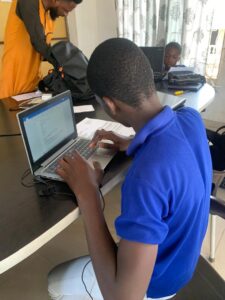Empowering Education for All: Bridging the Digital Divide with Technology

In an increasingly digital world, access to technology has become a critical factor in ensuring educational equity. The digital divide, characterized by disparities in technology access and skills, poses significant challenges to students’ learning experiences. This article explores how technology can serve as an educational equalizer, bridging the gap and promoting equitable opportunities for all learners.
Understanding the Digital Divide:
The digital divide refers to the unequal distribution of technology resources across different populations. Factors contributing to this divide include economic limitations, geographical disparities, and social barriers. In the context of education, the digital divide can hinder students’ ability to access information, collaborate, and participate fully in the learning process.
Technology as an Educational Equalizer: Technology has been a source of blessing in nearly every aspect of life, including the concept of education. Technological innovations and advancements have transformed the status and accessibility of education. Below are a few ways technology has contributed as an educational equalizer:
1. Internet Access: The Internet provides a wealth of educational resources, from online textbooks to interactive learning platforms. Students with reliable internet access have direct contact and can explore diverse subjects and engage in self-directed learning.
2. Computers and Tablets: Schools equipped with computers and tablets enable students to research, create, and collaborate. These devices empower learners to develop digital literacy skills and prepare for the modern workforce.
3. Educational Software: Interactive software and apps enhance learning experiences. Adaptive learning platforms such as Kahoot, Kajabi, and Thinkific personalize content based on students’ needs, ensuring individualized support.
Challenges in Bridging the Digital Divide:
There’s no such thing with its pros without its cons; despite the several benefits of harnessing the power of technology to bridge the digital divide, such as equal access to opportunities, enhanced education, economic empowerment, and more, different challenges are being faced in the process. Some of these challenges are briefly highlighted below:
1. Economic Barriers: Not all families can afford technology devices or internet subscriptions. Low-income households face difficulties accessing educational content online.
2. Infrastructure Limitations: Rural areas and developing countries often lack reliable internet infrastructure. Students in these regions struggle to connect to online resources.
3. Socio-Cultural Factors: Digital literacy varies among different demographics. Language barriers, a lack of familiarity with technology, and cultural norms can hinder equitable access.
Strategies for Bridging the Digital Divide:
To address the above challenges, different strategies have been devised to ensure digital inclusion. Some of these strategies are concisely discussed below:
1. Government Initiatives: Policymakers can allocate funds for technology infrastructure in schools and provide subsidies for low-income families. National broadband plans can extend internet coverage to underserved areas.
2. Private Sector Partnerships: Technology companies can collaborate with schools to donate devices, offer training programs, and sponsor community centres with internet access.
3. Community-Based Approaches: Libraries, community centres, and schools can serve as hubs for technology access. Offering free Wi-Fi and computer labs ensures that students can bridge the digital gap.
4. Non-profit Organizations: NGOs working toward digital inclusion can provide training sessions, distribute refurbished devices, and advocate for policies that promote equitable access. Anwojue Hope Foundation (AHF) is a popular NGO that has adopted this strategy in several instances, such as the payment of necessary school and educational fees to ensure underprivileged individuals have access to quality education. This foundation has also held several career talks and inter-school debate competitions to promote interest in educational and developmental programs. AHF has also distributed several educational materials to individuals who lack access to these basic materials to ensure equitable access for all individuals to education.
Impact of Bridging the Digital Divide:
Below are certain benefits of the efforts made to bridge the digital divide:
1. Access to Education: Students from marginalized backgrounds gain equal access to educational content. Online courses, virtual field trips, and e-books become accessible to all.
2. Enhanced Learning Outcomes: Technology-enabled learning improves student engagement, comprehension, and retention. Interactive multimedia aids understanding.
3. Empowerment through Digital Literacy: Equipping students with digital skills empowers them to navigate the digital landscape, find employment, and participate in civic life.
Case Studies and Success Stories
1. One Laptop per Child (OLPC)
The One Laptop per Child (OLPC) initiative aimed to provide affordable laptops to children in developing countries. Here’s how it made a difference:
- Low-Cost Laptops: OLPC designed rugged, low-cost laptops specifically for educational purposes. These laptops were durable, energy-efficient, and equipped with basic software.
- Empowering Learning: By distributing these laptops to students, OLPC empowered them to explore digital content, collaborate, and engage in self-directed learning.
- Local Content Creation: OLPC encouraged the creation of localized educational content, ensuring that students could learn in their native languages.
- Impact: OLPC reached millions of children worldwide, bridging the digital gap and fostering a love for learning.
2. Google’s Project Loon
Google’s Project Loon aimed to provide internet access to remote and underserved areas using high-altitude balloons. Here’s how it worked:
- Balloon-Based Internet: Project Loon deployed large helium balloons into the stratosphere, creating a network of floating cell towers.
- Global Coverage: These balloons provided internet connectivity to areas where traditional infrastructure was challenging to establish.
- Emergency Response: Project Loon played a crucial role during natural disasters by restoring communication lines quickly.
- Community Impact: Students in remote villages gained access to educational resources, online courses, and communication tools.
Future Directions and Recommendations
1. Explore Emerging Technologies
- 5G Networks: The rollout of 5G networks promises faster internet speeds and lower latency. Leveraging 5G can enhance digital access to education.
- Satellite Internet: Satellite-based internet services can reach even the most remote regions, ensuring connectivity beyond terrestrial infrastructure.
2. Advocate for Policies
- Digital Inclusion Policies: Governments should prioritize digital inclusion by creating policies that address affordability, accessibility, and digital literacy.
- Subsidies and Grants: Subsidies for technology devices and internet subscriptions can make them more accessible to low-income families.
3. Encourage Collaboration
- Government, NGOs, and Private Sector: Collaboration among stakeholders is essential. Governments, non-profits, and private companies can work together to bridge the divide.
- Community Engagement: Engage local communities to identify specific needs and tailor solutions accordingly.
Conclusion:
In essence, bridging the digital divide requires concerted efforts, innovative solutions, and a commitment to equity. By leveraging technology and fostering collaboration, we can create a more inclusive educational landscape for all learners.
Remember, every step we take toward digital equity contributes to a brighter future for generations to come.


